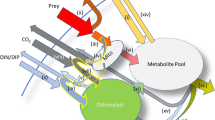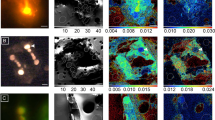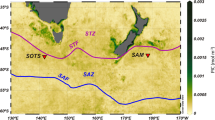Abstract
Cyanobacteria (blue-green algae) commonly occur in the phytoplankton of lakes and reservoirs and sometimes develop as blooms which can cause deoxygenation, toxin production and nuisance odours1. The factors which govern the occurrence and seasonal development of such blooms in surface waters are imprecisely understood and little is known about the origins of the bloom-forming populations within particular water bodies (see, however, refs 2,3). Using 15N as tracer, we show here that the appearance of Microcystis in the phytoplankton of an experimental enclosure in the summer of 1977 correlated directly with the presence of particulate 15N which could only have been sediment-derived and which originated mainly from Microcystis cells deposited on the sediment surface the previous year. The most plausible explanation is that Microcystis overwinters on the sediment surface and by so doing provides an inoculum of colonies from which the epilimnetic population develops the following summer4–8. Possible mechanisms which allow the mass recruitment of Microcystis to the plankton are considered elsewhere2,3.
This is a preview of subscription content, access via your institution
Access options
Subscribe to this journal
Receive 51 print issues and online access
$199.00 per year
only $3.90 per issue
Buy this article
- Purchase on Springer Link
- Instant access to full article PDF
Prices may be subject to local taxes which are calculated during checkout
Similar content being viewed by others
References
Fogg, G. E., Stewart, W. D. P., Fay, P. & Walsby, A. E. The Blue-Green Algae (Academic, London, 1973).
Reynolds, C. S. & Walsby, A. E. Biol. Rev. 50, 437–481 (1975).
Reynolds, C. S. Proc. R. Soc. B154, 24–50 (1973).
Topachevskiy, A. V., Bradinskiy, L. P. & Sirenko, L. A. Hydrobiol. J. 5, 1–10 (1969).
Sirenko, L. A. BLL Translation RTS8132.
Kappers, F. E. Hydrobiol. Bull. 10, 164–171 (1976).
Reynolds, C. S. & Rogers, D. A. Hydrobiologia 48, 17–23 (1976).
Tow, M. J. Limnol. Soc. Sth Afr. 5, 9–10 (1979).
Lack, T. J. & Lund, J. W. G. Freshwater Biol. 4, 399–415 (1974).
Christofi, N., Preston, T. & Stewart, W. D. P. Water Res. (in the press).
Reynolds, C. S. & Butterwick, C. Algological Studies 23, Arch. Hydrobiol., Suppl. 56, 166–183 (1979).
Mortimer, C. H. J. Ecol. 30, 147–200 (1942).
Ross, P. J. & Martin, A. E. Analyst 95, 817–822 (1970).
Lund, J. W. G., Kipling, C. & LeCren, E. D. Hydrobiologia 11, 143–170 (1958).
Author information
Authors and Affiliations
Rights and permissions
About this article
Cite this article
Preston, T., Stewart, W. & Reynolds, C. Bloom-forming cyanobacterium Microcystis aeruginosa overwinters on sediment surface. Nature 288, 365–367 (1980). https://doi.org/10.1038/288365a0
Received:
Accepted:
Issue Date:
DOI: https://doi.org/10.1038/288365a0
This article is cited by
-
Phylogenic diversity of bacteria associated with potentially toxic cyanobacteria Microcystis aeruginosa: a synthesis on its bloom dynamics
Folia Microbiologica (2023)
-
Differences in survivability and toxic potential among Microcystis colonies of different sizes in sediment
Environmental Science and Pollution Research (2023)
-
Transcriptional response of Microcystis aeruginosa to the recruitment promoting-benthic bacteria
Journal of Oceanology and Limnology (2022)
-
Decades needed for ecosystem components to respond to a sharp and drastic phosphorus load reduction
Hydrobiologia (2020)
-
Culture-independent and culture-dependent analyses of the bacterial community in the phycosphere of cyanobloom-forming Microcystis aeruginosa
Scientific Reports (2019)
Comments
By submitting a comment you agree to abide by our Terms and Community Guidelines. If you find something abusive or that does not comply with our terms or guidelines please flag it as inappropriate.



